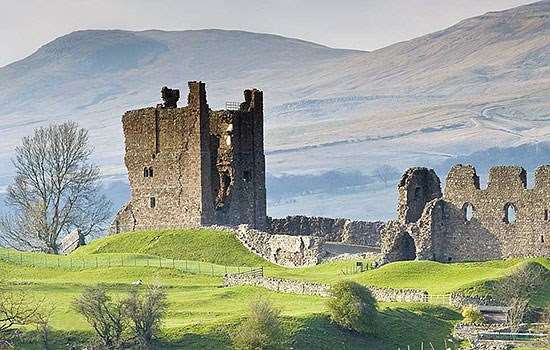Merchant of the borders
The life and times of Laurence of Ludlow offer an early example of one of the oldest tales of English aspiration: the rich tradesman redefining himself as a country squire.
But his story, and that of Stokesay Castle, Shropshire, is above all about the medieval wool trade – its unique status, the extraordinary prizes it created for its savviest merchants, and the perils of late 13th-century international travel.
In the 13th century wool was England’s most important export, and the principal source of the nation’s wealth. The wool of the Shropshire and Herefordshire borderlands was of particularly high quality. And from the 1270s onwards Laurence dealt, as his father had before him, in vast quantities of the fleeces produced by local sheep owners – magnates, monasteries and farmers.
Champagne lifestyle
Much of Laurence’s business was done in Shrewsbury, but he had an office in London, and also traded overseas. He personally sold wool to merchants in the Low Countries, where it fed the cloth industry of towns like Ghent and Bruges. He attended at least one fair at Champagne, in north-west France, where merchants gathered from all over Europe.
His enterprises at home and abroad made Laurence staggeringly rich. What was a wealthy medieval merchant to do with all his money? The answer was to invest in landed property. Then, as now, ownership of land bought status – which a fine house only enhanced.
Laurence’s profits were such that he was able to lend money to Edward I, as well as many of the great lords of the Welsh borderlands. The manor of Stokesay, which he bought in 1281, would have been easily within his means.
A house in the country
Building at Stokesay began in about 1285, and Laurence moved in about six years later. The fine building proclaimed its creator as a man of great wealth and taste. Laurence might well have agreed with the Nottinghamshire wool merchant who engraved these words on the windows of his new house:
I praise God and ever shall
It is the sheep hath paid for all.
Laurence’s wealth and status brought him and his family into contact with other important people. In 1290, the clerk of Richard Swinfield, Bishop of Hereford, recorded Swinfield’s visit to Stokesay. He records that the bishop paid for large amounts of food and drink, together with other food items as gifts. It’s likely that the visit included a feast at the castle, at which the abbot of Haughmond, who owned the rights to the church at Stokesay, was also present. You can find out more about the occasion by exploring the reconstruction drawing below.
Reconstruction illustration below by Peter Urmston (© Historic England)
A feast at Stokesay Castle
Use the image windows to explore this reconstruction drawing and find out about the feast held by Laurence of Ludlow in 1290 for the Bishop of Hereford and the Abbot of Haughmond in the hall at Stokesay.
You can also find out more about the architecture of the hall itself.
Fleeced
Laurence clearly had little intention of retiring to his new country home. Money and business acumen had bought him influence as well as property, and by 1294 he was advising Edward I.
It was thanks to Laurence’s suggestion that Edward, desperate for money to finance a war with France, abandoned his plan for a wholesale seizure of wool. He was persuaded to raise revenue in a different way – by tripling the customs rate on wool exports, as well as arranging loans in wool itself.
The wool producers were outraged. The burden of the king’s needs fell on them, rather than the merchants.
Final voyage
Laurence was also to be the king’s paymaster, delivering wool and money to England’s continental allies. A fleet carrying both left London for Flanders in November 1294, under his command.
But he never reached his destination. On the night of 26 November, the fleet ran into a storm. Most of the ships (and indeed wool) survived, but Laurence’s vessel was wrecked off the Suffolk coast. He drowned.
The wool producers couldn’t conceal their delight. As one chronicler wrote: ‘Because he sinned against the wool-growers, he was swallowed by the waves in a ship full of wool.’
Laurence’s descendants were to enjoy his legacy – they remained lords of Stokesay for more than two centuries, living among the Shropshire gentry as respected country squires. However, there is an irony in the relationships of Laurence and his grandson, Sir Laurence, with their kings and the wool industry. While the first Laurence worked with Edward I to levy extra taxes on wool, his grandson suffered from punitive taxes raised by Edward III (Edward I’s grandson) on the wool industry.
Find out more
-

History of Stokesay Castle
Read a full history of Stokesay Castle, built in the 1280s by Laurence of Ludlow and one of the first fortified manor houses in England.
-

Faithful subject or rebel? A 14th-century knight and a protest poem
In 1342 Sir Laurence Ludlow of Stokesay Castle was arrested for failing to collect taxes. Was he connected with a protest poem composed at the time?
-

Buy the guidebook to Stokesay Castle
Packed with plans, reconstruction drawings and historic photos, this guidebook gives a vivid account of the castle’s history and its occupants.
-

Medieval Castles
Discover the stories held within the walls of England’s greatest fortifications and learn about the rise and fall of the medieval castle.

